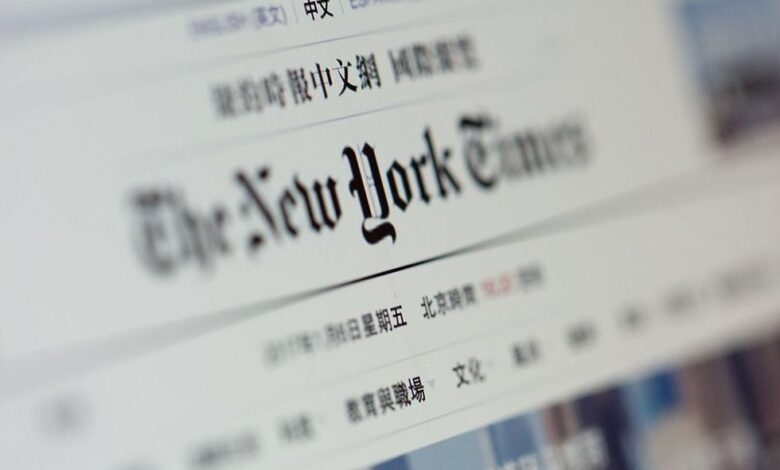Why is the New York Times carrying water for the CCP?

In a prior article, I exposed the tangled web of the New York Times’ obsessive propaganda series, which attempted to discredit Shen Yun Performing Arts.
As it turned out, the lead author of the series, Nicole Hong, is only a degree of separation away from the Chinese Communist Party, which has launched a global propaganda campaign against the group and Falun Gong, the spiritual movement that founded Shen Yun. The CCP has targeted Falun Gong for extermination since 1999. Hong’s father has worked at two CCP-backed universities and was an honorary overseas director for a group with ties to high-ranking CCP officials.
The New York Times began a spree of desperate articles attempting to defend communism.
Though this may explain why Hong was motivated to do the CCP’s bidding, why did the New York Times allow it?
A walk through the paper’s history with communism leaves no doubt that its recent attacks on Shen Yun are consistent with its past willingness to carry water for authoritarian regimes.
Whitewashing communism
Perhaps the most infamous example of the Times doing the bidding for a communist regime was its coverage of Josef Stalin, who was responsible for more deaths through mass killings than Nazi Germany.
Walter Duranty, the Times’ Moscow bureau chief, wrote 13 propaganda articles, winning him a Pulitzer Prize in 1932. The articles gave a favorable view of Soviet communist policies, downplayed Stalin’s brutality, and claimed that the wealthy weren’t being physically exterminated but instead “liquidated as a class.”
In short, Duranty was doing the 1930s equivalent of clicking “copy and paste” on the very same Soviet propaganda he was being presented — without performing the due diligence expected of a journalist.
In 1933, Duranty outright denied the famine that was visible before his very eyes. He called reports of starvation “exaggeration or malignant propaganda,” despite evidence to the contrary from other journalists.
Hollywood got it right — for once
The Times’ reporting was so misleading that even liberal Hollywood pushed back. The 2019 film “Mr. Jones” tells the true story of Gareth Jones, the journalist who first reported on the Soviet famine of 1930 to 1933. That famine killed as many as 8.7 million people, including up to 5 million during the Holodomor in Ukraine and 2.5 million during the Asharshylyk in Kazakhstan.
In 2017, the Times began a spree of desperate articles attempting to defend communism. Its “Red Century” series, launched to mark the 100th anniversary of the Bolshevik Revolution, included several opinion pieces accused of romanticizing or downplaying the horrors of communism.
In one example, the Times ran an article headlined “Why Women Had Better Sex Under Socialism,” written by Kristen R. Ghodsee, who later published a book with the same title. The piece typified the paper’s vain effort to find redeeming qualities in socialist and communist systems.
From the headline alone, the piece became one of history’s most mercilessly mocked New York Times articles. But those who read past the headline found even more to laugh at.
Among the “evidence” Ghodsee presented was an interview she conducted with a 65-year-old Bulgarian woman who had lived under communism for 43 years. The woman claimed that the free market — rather than aging out of her 20s — hampered her “ability to develop healthy amorous relationships.”
The millions of women who starved under the communist regime could not be reached for comment.
Bias laid bare
That was just one of the absurd articles the Times published that year defending communism. Other doozies included an article portraying Vladimir Lenin as an environmentalist whose love for nature led to conservation efforts in Russia — while ignoring the environmental destruction under his successors.
Another piece argued that the American Communist Party in the mid-20th century gave people a sense of moral authority and purpose in fighting social injustice while downplaying its complicity in covering up or supporting Soviet atrocities. Yet another article argued that Bolsheviks raised their children with “world literature” and communal values, suggesting a sophisticated cultural upbringing under communism — an ideology that destroys culture.
A number of reasons could explain why the New York Times might amplify an anti-Shen Yun narrative beyond a supposed journalistic duty. For one, the paper has a well-documented anti-religious bias. It may also be waging a proxy battle due to Shen Yun’s ties to the Epoch Times — a competitor that heavily criticizes the Times.
The reality is that Shen Yun is growing, and a juicy exposé on a “mysterious” financially successful dance troupe will drive clicks and subscriptions, especially amid the Times’ desperate bid to maintain the relevance it deservedly lost.




